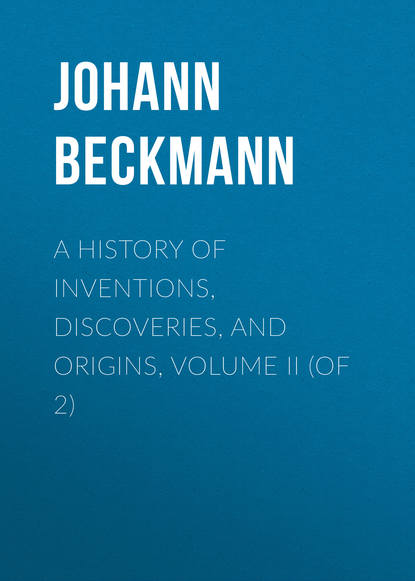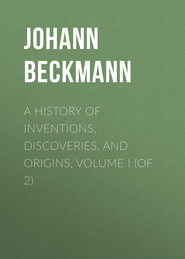По всем вопросам обращайтесь на: info@litportal.ru
(©) 2003-2024.
✖
A History of Inventions, Discoveries, and Origins, Volume II (of 2)
Настройки чтения
Размер шрифта
Высота строк
Поля
1115
See La Grande Chirurgie de M. Guy de Chauliac, Medecin tres-fameux de l’Université de Montpelier, restituée par M. Laurens Joubert. A Rouen 1641, 8vo.
1116
There are various editions of the statutes of this order. 1. Nova Stat. ord. S. Joannis Hierosolymitani. Madriti 1577, small folio. 2. Privilegia ordinis S. Jo. Hierosol. small folio, Romæ 1588. 3. Statuta Hospitalis, without place or date, small folio. Each copy, however, has many things which in the others are wanting. 4. Histoire de Malthe, avec les Statuts et les Ordonnances de l’Ordre. Paris, 1643, fol. 5. Codice del sacro militare ordine Gerosolimitano. In Malta 1782, fol. The words relating to this subject may be found in Titulo quarto, xi et xii.
1117
The proofs of this singular account may be seen in Assemani Bibliotheca Orientalis, tom. iii. P. 2. pag. CMXL.
1118
Diogen. Laert. lib. i. seg. 55. This regulation has been praised by many. Plato in Menexemo, Æschines contra Ctesiphon.
1119
Suidas, v. αδυνατοι, Lysiæ Orat. 23, contra Pancleonem.
1120
Cod. Theodos. lib. vii. tit. 20, 8. Brissonius v. Causarius.
1121
Livius, ii. 47, p. 458. – Dio Cassius, lib. lv. 23, p. 793. – Sueton. Vita Jul. Cæsar. cap. 38. To this subject belong many passages in the Auctor. Rei Agrar. pp. 15, 16, 17, 205, ed. Amstelod. 1674, 4to.
1122
De Imperio Romano, lib. ii. cap. 12. Argent. 1612, 4to.
1123
Lib. i. cap. 7, ext. 10.
1124
Brisson de Verbor. Signif. v. Meritorius.
1125
p. 146.
1126
Histor. lib. vi. cap. 20.
1127
This I learn from Pontac’s Observations on the Chronicon of Eusebius, p. 507, Chronica trium illustrium auctorum. Burdigalæ 1604, fol.
1128
Platina de vitis Pontificum, p. 48, 1664, 12mo.
1129
Lamprid. vita Alex. Severi, cap. 49.
1130
Walch’s Histor. der Päbste. Göttingen, 1758, 8vo, p. 57.
1131
Roma Vet. et Nova. lib. iii. cap. 21.
1132
See Hardouin’s Observations on Plin. lib. viii. seg. 74, p. 477; and the figure of the coin, plate vii.
1133
Annæ Comnenæ Alexiados lib. xv. p. 484. The authoress says expressly, that the name ὀρφανοτροφεῖον is taken only a parte potiori, as it is known that at later periods not only children who had lost their parents, but others also who were entirely or in part educated at the public expense, and likewise the children of the choir, were called ὀρφανοί. See Du Cange, Gloss. Græcit. The emperor was accustomed to send orphans to the monasteries to be educated and instructed; but with this express intimation, that they were not to be treated and instructed as serfs, but as the children of freemen. – Anna Comn. p. 381.
1134
[There is a tradition that this institution owes its rise to the patriotic exertions of Nell Gwynn, the celebrated mistress of Charles II. A paragraph in a newspaper of the day seems to give some little strength to the supposition that her family once dwelt in the vicinity; and a public-house still exists at no great distance from the hospital, having her portrait for its sign, with an inscription ascribing to her the merit of the foundation. The anonymous author also of the life of Eleanor Gwynn states, that it was at her instigation that this noble charity was established. “Another act of generosity,” he says, “which raised the character of this lady above every other courtezan of these or any other times, was her solicitude to effect the institution of Chelsea Hospital. One day, when she was rolling about town in her coach, a poor man came to the coach-door soliciting charity, who told her a story, whether true or false is immaterial, of his having been wounded in the civil wars in defence of the royal cause. This circumstance greatly affected the benevolent heart of Eleanor; she considered that (besides the hardships of their being exposed to beggary by wounds received in defence of their country) it seemed to be the most monstrous ingratitude in the government to suffer those to perish who had stood up in their defence.
“Warm with these reflections and the overflow of pity, she hurried to the king, and represented the misery in which she had found an old servant; entreated that he might suffer some scheme to be proposed to him towards supporting those unfortunate sons of valour, whose old age, wounds, or infirmities, rendered them unfit for service; so that they might not close their days with repining against fortune, and be oppressed with the misery of want.”
Another anecdote of that period states, with somewhat more probability, “That when the garrison was withdrawn from Tangiers, there was among them a considerable number of aged and decrepid persons. It was therefore proposed to build an hospital for them; and the king being applied to for a piece of ground for the site, he offered the spot on which king James’s College stood; but recollecting himself, ‘Odso,’ says he, ‘’tis true I have already given that land to Nell, here.’ She, who was one of the most generous and benevolent of human beings, immediately said, ‘Have you so, Charles? then I will return it to you again for this purpose;’ and the hospital was accordingly erected. The king however built a house for Eleanor in Pall Mall.”
It is however very probable, according to Mr. Evelyn’s Memoirs, that the design originated with Sir Stephen Fox, who for some years had been paymaster of the forces, and certainly had better opportunities of becoming acquainted with the wants and distresses of the aged and worn-out veterans, great numbers of whom had been thrown on the charity of the country at this period. The building was erected under the superintendence of Sir C. Wren, and cost £150,000. It usually contains about 500 invalids; there are also a number of out-door pensioners, amounting to about 85,000.]
1135
An Historical Account of the Royal Hospital for Seamen at Greenwich. London, 1789, 4to. [The foundation-stone of this magnificent building was laid on June 3, 1696, and the whole of the superstructure, under the honorary superintendence of Sir Christopher Wren, was finished within two years; the hospital was opened for the reception of pensioners in 1705. In the year of the foundation an act was passed, 7 and 8 William III., cap. 21, by which sixpence a month of the wages of all seamen belonging to the royal navy is appropriated to the benefits of the institution. Since that time large sums have been bequeathed for the use of the hospital, and the buildings have been successively enlarged and improved.
The indoor pensioners, of whom there are 2700 (which number is kept up by filling the vacancies twice a month), are maintained, clothed, and lodged, having also a weekly allowance for pocket-money.
By the act, 10 Anne, cap. 27, it is enacted that the seamen of the merchant service shall contribute equally with those of the royal navy; and that such of the former as may be wounded in the defence of property belonging to Her Majesty’s subjects, or otherwise disabled while capturing vessels from an enemy, shall also be admitted to the benefits of the institution. The money received from visitors and other sources is appropriated to the support of a school, wherein upwards of 4000 boys have been (1838) educated, from the foundation of the establishment to the present time. There are also about 32,000 out-pensioners.]
1136
Even Alexander the Great undertook this office, as Plutarch expressly says in his life.
1137






